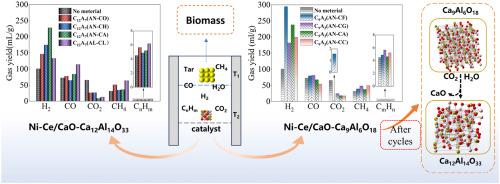Synthesis of Ni-Ce loaded on CaO-Ca9Al6O18/Ca12Al14O33 sorbent-catalyst bifunctional materials for enhancing hydrogen production from biomass gasification
IF 6.2
2区 工程技术
Q2 ENERGY & FUELS
引用次数: 0
Abstract
Ni–Ce/CaO–Ca12Al14O33 (Ni–Ce/C12A7) and Ni–Ce/CaO–Ca9Al6O18 (Ni–Ce/C9A3) catalysts were synthesized from different calcium–aluminum precursors and evaluated for H2 production via catalytic reforming of pine sawdust. At a Ni/Ce molar ratio of 1.5, Ni–Ce/C9A3(AN–CF)—prepared using Al(NO3)3·9H2O (AN) and Ca(CHO2)2 (CF)—exhibited the best performance, achieving a peak H2 concentration of 90.97 vol% and an H2 yield of 294.31 mL/g, compared with 85.51 vol% and 228.19 mL/g for Ni–Ce/C12A7(AN–CA). The superior performance was attributed to the uniform, mesh-like pore network of Ni–Ce/C9A3(AN–CF) and to the stability of its average pore diameter during catalytic process. In cyclic tests, Ni–Ce/C9A3(AN–CF) maintained stable performance for the first four cycles but underwent rapid deactivation from cycle 5 and was nearly deactivated by cycle 10. Ni–Ce/C12A7(AN–CA) exhibited a more gradual performance decline. The observed deactivation was primarily ascribed to the phase transformation of Ca9Al6O18 to Ca12Al14O33 under H2O–CO2 atmospheres, which caused pore collapse and sintering of Ni–Ce active species. Although Ca9Al6O18 exhibited greater resistance to CaO-particle sintering than Ca12Al14O33, its thermodynamic instability under reaction conditions limited long-term cyclic performance.

负载Ni-Ce的CaO-Ca9Al6O18/Ca12Al14O33吸附-催化剂双功能材料的合成
以不同的钙铝前驱体为原料合成了Ni-Ce / CaO-Ca12Al14O33 (Ni-Ce /C12A7)和Ni-Ce / CaO-Ca9Al6O18 (Ni-Ce /C9A3)催化剂,并对松木木屑催化重整制氢性能进行了评价。在Ni/Ce摩尔比为1.5时,用Al(NO3)3·9H2O (AN)和Ca(CHO2)2 (CF)制备的Ni - Ce/C9A3(AN - CF)表现最好,H2峰浓度为90.97 vol%, H2产率为294.31 mL/g,而Ni - Ce/C12A7(AN - Ca)的H2峰浓度为85.51 vol%, H2产率为228.19 mL/g。优异的性能归因于Ni-Ce /C9A3(AN-CF)均匀的网状孔隙网络及其在催化过程中平均孔径的稳定性。在循环试验中,Ni-Ce /C9A3(AN-CF)在前四个循环中保持稳定的性能,但从第5个循环开始迅速失活,到第10个循环时几乎失活。Ni-Ce /C12A7(AN-CA)的性能下降更为缓慢。失活的主要原因是在H2O-CO2气氛下,Ca9Al6O18向Ca12Al14O33相变,导致孔隙坍塌和Ni-Ce活性物质烧结。尽管Ca9Al6O18表现出比Ca12Al14O33更强的抗cao颗粒烧结性能,但其在反应条件下的热力学不稳定性限制了其长期循环性能。
本文章由计算机程序翻译,如有差异,请以英文原文为准。
求助全文
约1分钟内获得全文
求助全文
来源期刊

Journal of The Energy Institute
工程技术-能源与燃料
CiteScore
10.60
自引率
5.30%
发文量
166
审稿时长
16 days
期刊介绍:
The Journal of the Energy Institute provides peer reviewed coverage of original high quality research on energy, engineering and technology.The coverage is broad and the main areas of interest include:
Combustion engineering and associated technologies; process heating; power generation; engines and propulsion; emissions and environmental pollution control; clean coal technologies; carbon abatement technologies
Emissions and environmental pollution control; safety and hazards;
Clean coal technologies; carbon abatement technologies, including carbon capture and storage, CCS;
Petroleum engineering and fuel quality, including storage and transport
Alternative energy sources; biomass utilisation and biomass conversion technologies; energy from waste, incineration and recycling
Energy conversion, energy recovery and energy efficiency; space heating, fuel cells, heat pumps and cooling systems
Energy storage
The journal''s coverage reflects changes in energy technology that result from the transition to more efficient energy production and end use together with reduced carbon emission.
 求助内容:
求助内容: 应助结果提醒方式:
应助结果提醒方式:


